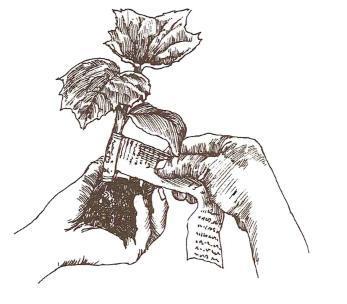Transplanting is a major step that can make or break your crop. It doesn't have to be traumatic to you or your plants, however, if you've thoroughly prepared the soil, and hardened off the plants well, and if you keep these few basic principles in mind.
Get the Right TimeTiming is everything: Peppers, eggplant, and okra are heat-loving plants. Although some vegetables can tolerate a frost, these three won't stand for it. It's important that the soil is at least 60° F and that all danger of frost is past before you set these plants out in the garden. Calling your local county Extension Service agent or the National Weather Service and asking for the first and last average frost date in your area is an easy way to get this information. Then check the days to maturity for varieties of pepper, eggplant and okra on the seed package or in your garden catalog. (Remember, the days to maturity for peppers and eggplant are from the time you set the transplants out into the garden, not from the time you first plant the seed indoors.) Choose varieties that will produce in the time you have available. You can also figure out if you have time for two plantings of these crops - some parts of the country do.
Transplant on a cloudy day: Bright sun can hurt newly planted seedlings, so always plan to transplant on an overcast day, late in the afternoon or in the evening.
Early PlantingGenerally, set out your plants the week after the last average frost date to be sure the tender young plants don't suffer from frostbite. To get a jump on the season, you can plant around the last average frost date (perhaps even two weeks before), depending on how warm the weather has been. You can also lay black plastic or IRT plastic mulch on the beds two weeks before transplanting. Plastic mulch helps to heat the soil so the transplants experience less shock. When you plant early and frost is expected, protect your plants with hotcaps or cloches, either store-bought or homemade of newspaper or wax paper.
Another trick to keep Jack Frost at bay and increase the heat around these plants is to make a ring of black roofing paper five to six inches high and six to eight inches in diameter. Using stakes to support the ring, place it so the plant is in the center of the circle. The black paper absorbs and holds the sun's heat, increasing the temperature in the area around the plant.
Plants Need a SoakIf you water your plants well about an hour before transplanting, the soil will stay firmly around the roots to protect them and make them easier to handle while you're putting them in the ground. The soil should clump together without being muddy.
Head Off CutwormsOne of the simplest treatments to prevent cutworm damage can be done when you transplant. Simply take a strip of newspaper two or three inches wide and wrap it around the stem of the plant. When you place the plant in its hole, make sure an inch of the newspaper strip is below the soil surface, withthe rest staying above ground. This prevents the dreaded cutworm from chewing through the stem of your tender young plant.
Getting ReadyRun through a checklist in your mind before you start to transplant. This will prevent you from reaching for something that isn't there while the roots of the plant you've just taken from its pot start to dry out. Is it cloudy or late in the day? Is the soil fully prepared? Are the plants properly hardened off? Do you have a shovel or trowel, fertilizer or compost, newspaper cutworm collars and watering can at hand? If not, do whatever is necessary before starting to transplant.
Even though you've hardened off your transplants, they still have tender roots. Getting them into the ground quickly will help prevent any damage to the roots and help minimize the shock.

 Victory Seed Company has all the seeds you want for your best garden in 2024.
Victory Seed Company has all the seeds you want for your best garden in 2024.
For 25 years, the family-owned Victory Seed Company has provided the highest quality vegetable, herb and flower seeds to families across the country. We are passionate about providing you the best seeds available that give excellent germination, robust plants, and the harvest you want. With a catalog of over a thousand varieties, we have everything, and our prices are the kinds that we'd want to pay. We have hundreds of yesterday's heirloom vegetables, as well as today's award winning hybrid selections. Get to know us by visiting our website and browsing through our online vegetable seed catalog.
| 1. Starting Eggplant, Pepper, and Okra Seeds Indoors |
| 2. Okra Seedling Care |
| 3. Hardening Off Pepper & Eggplant Transplants |
| 4. Peppers and Eggplant in Containers |
| 5. Soil Preparation for Eggplant and Peppers |
| 6. Raised Beds and Spacing for Peppers and Friends |
| 7. Transplanting Eggplant, Peppers, and Okra ← you're on this article right now |
| 1. Starting Eggplant, Pepper, and Okra Seeds Indoors |
| 2. Okra Seedling Care |
| 3. Hardening Off Pepper & Eggplant Transplants |
| 4. Peppers and Eggplant in Containers |
| 5. Soil Preparation for Eggplant and Peppers |
| 6. Raised Beds and Spacing for Peppers and Friends |
| 7. Transplanting Eggplant, Peppers, and Okra ← you're on this article right now |